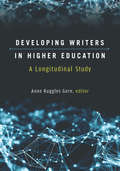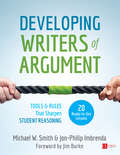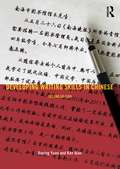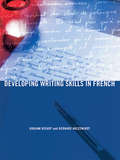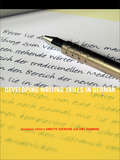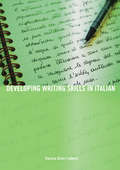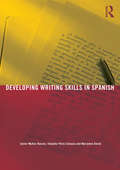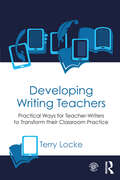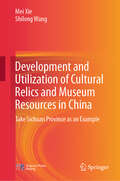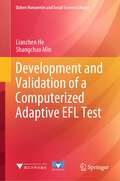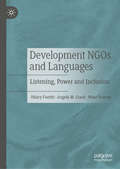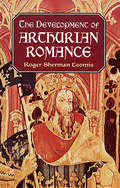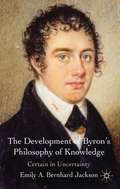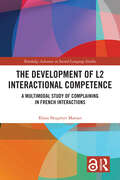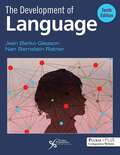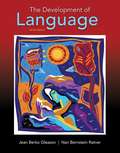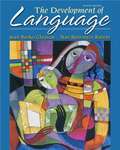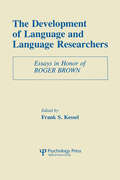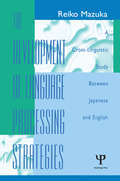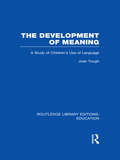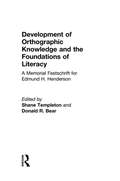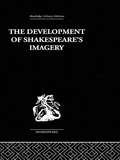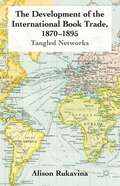- Table View
- List View
Developing Writers in Higher Education: A Longitudinal Study (Sweetland Digital Rhetoric Collaborative)
by Anne R GereFor undergraduates following any course of study, it is essential to develop the ability to write effectively. Yet the processes by which students become more capable and ready to meet the challenges of writing for employers, the wider public, and their own purposes remain largely invisible. Developing Writers in Higher Education shows how learning to write for various purposes in multiple disciplines leads college students to new levels of competence. This volume draws on an in-depth study of the writing and experiences of 169 University of Michigan undergraduates, using statistical analysis of 322 surveys, qualitative analysis of 131 interviews, use of corpus linguistics on 94 electronic portfolios and 2,406 pieces of student writing, and case studies of individual students to trace the multiple paths taken by student writers. Topics include student writers’ interaction with feedback; perceptions of genre; the role of disciplinary writing; generality and certainty in student writing; students’ concepts of voice and style; students’ understanding of multimodal and digital writing; high school’s influence on college writers; and writing development after college. The digital edition offers samples of student writing, electronic portfolios produced by student writers, transcripts of interviews with students, and explanations of some of the analysis conducted by the contributors. This is an important book for researchers and graduate students in multiple fields. Those in writing studies get an overview of other longitudinal studies as well as key questions currently circulating. For linguists, it demonstrates how corpus linguistics can inform writing studies. Scholars in higher education will gain a new perspective on college student development. The book also adds to current understandings of sociocultural theories of literacy and offers prospective teachers insights into how students learn to write. Finally, for high school teachers, this volume will answer questions about college writing.
Developing Writers of Argument: Tools and Rules That Sharpen Student Reasoning (Corwin Literacy)
by Michael W. Smith Jon-Philip ImbrendaThe ability to make effective arguments is not only necessary in students’ academic lives, it’s a transferable skill that’s essential to students’ future success as critical thinkers and contributing members of society. But in the here and now, how do we engage students and ensure they understand argument writing’s fundamental components? How do we take them from "Here’s what I think" to "Here’s what I think. Here’s what makes me think that. And here’s why it matters"? This stunning, full-color book by Michael Smith and Jon-Philip Imbrenda shows the way, with ready-to-implement lessons that make argument writing topical and relevant. Students are first asked to form arguments about subjects that matter to them, and then to reflect on the structure of those arguments, a process that provides learners with valuable, reusable structural models. Throughout the book, the authors provide helpful instructional tools, including Literary, nonfiction, and author-created simulated texts that inspire different points of view Essential questions to create a context that rewards argumentation Lessons introducing students to the three essential elements of an argument—claim, data, and warrant—and how to make each effective Questioning probes, semantic differential scales, and other innovative instructional approaches Samples of writing from the authors’ own students, and enlightening details on how this work informed the authors’ subsequent teaching approach Complete with guidance on applying the lessons’ techniques in a broader, unit-wide context, Developing Writers of Argument offers a practical approach for instructing students in this crucial aspect of their lifelong development.
Developing Writers of Argument: Tools and Rules That Sharpen Student Reasoning (Corwin Literacy)
by Michael W. Smith Jon-Philip ImbrendaThe ability to make effective arguments is not only necessary in students’ academic lives, it’s a transferable skill that’s essential to students’ future success as critical thinkers and contributing members of society. But in the here and now, how do we engage students and ensure they understand argument writing’s fundamental components? How do we take them from "Here’s what I think" to "Here’s what I think. Here’s what makes me think that. And here’s why it matters"? This stunning, full-color book by Michael Smith and Jon-Philip Imbrenda shows the way, with ready-to-implement lessons that make argument writing topical and relevant. Students are first asked to form arguments about subjects that matter to them, and then to reflect on the structure of those arguments, a process that provides learners with valuable, reusable structural models. Throughout the book, the authors provide helpful instructional tools, including Literary, nonfiction, and author-created simulated texts that inspire different points of view Essential questions to create a context that rewards argumentation Lessons introducing students to the three essential elements of an argument—claim, data, and warrant—and how to make each effective Questioning probes, semantic differential scales, and other innovative instructional approaches Samples of writing from the authors’ own students, and enlightening details on how this work informed the authors’ subsequent teaching approach Complete with guidance on applying the lessons’ techniques in a broader, unit-wide context, Developing Writers of Argument offers a practical approach for instructing students in this crucial aspect of their lifelong development.
Developing Writing Skills in Chinese
by Boping Yuan Kan QianDeveloping Writing Skills in Chinese has been devised for post-intermediate students who need to write Chinese in the course of their life, work or study. Each unit covers a specific style of writing and is reinforced with a rich selection of model texts. All texts are followed by supporting notes examining the formats, styles, grammar structures or special phrases featured. A wide variety of exercises are featured throughout, and each unit concludes with a helpful glossary given in Chinese characters, pinyin and English translations. An answer key is also included in the back of the book. The following writing styles and genres are covered: Personal correspondence—greetings and condolences, explanations and apologising, making arrangements and keeping in touch Formal writing—announcements and adverts, letters of enquiry and application, business correspondence, developing an argument, facts and data Narration—story narratives, reporting speech, exemplifying and summarising Description and comparison—outlining people’s characters, physical attributes and appearance, places and weather This new edition has been comprehensively revised and updated throughout. It includes a brand-new chapter on narratives and there is new coverage of digital communication methods such as text messages and emails. An additional English-Chinese glossary is also available for free download at http://www.routledge.com/books/details/9780415678896/ Developing Writing Skills in Chinese will help students to write coherently, clearly and appropriately in a variety of contexts. It is suitable for both classroom and self-study use.
Developing Writing Skills in French
by Graham Bishop Bernard HaezewindtDesigned for intermediate to advanced students, this text equips readers with the necessary skills to write confidently in French in a range of situations. Suitable for use as a classroom text or as a self-study course, it is carefully structured to ensure a better understanding of the effect of choice of words, register and style.Each chapter contains a selection of model texts, activities and clear notes on the format, style and language demonstrated. Every activity also has a model answer in the key, which also offers advice, explanations and further examples to support the student's learning. Features include:* key learning points clearly indicated at the beginning of each chapter* a rich selection of model texts from a variety of different media.Based on a well-reviewed Open University course and written by experienced teachers of the language, Developing Writing Skills in French has been trialled with non-native speakers of French to produce a valuable resource that will help students write appropriately for a variety of contexts.
Developing Writing Skills in German
by Annette Duensing Uwe BaumannDeveloping Writing Skills in German, is a unique course designed to improve the reading and writing skills of intermediate students of German. Presenting a wide range of authentic written materials, the book aims to develop reading strategies and the ability to write texts of various types - essays, articles and reviews - while imparting an understanding of important aspects of German society. From the environment to consumerism, each chapter focuses on a different theme and concentrates on the advancement of particular skills; all the chapters conclude with a task appropriate to the skills focus of the section. Summary writing, note-taking, the use of mind-maps to collect ideas, and other strategies for successful writing in German are presented here. This course is suitable both for classroom use and independent study, with feedback and answer key supplied at the back of the book.
Developing Writing Skills in Italian (Developing Writing Skills)
by Theresa Oliver-FedericiDeveloping Writing Skills in Italian has been specifically designed for upper-intermediate students of Italian who need to write Italian for personal, business and academic purposes. With a strong focus on writing as a meaningful and valuable skill in itself, Developing Writing Skills in Italian supports the learner throughout the process of writing, from the planning and drafting stages to the revising and editing of a final version, enriching and extending the learners’ lexical, grammatical and communicative writing skills. Divided into four logically structured sections the learner can work through a range of realistic and contextualized writing tasks which will allow them to master a variety of styles, registers and formats. Features include: flexible structure a summary of learning points clearly indicated at the beginning of each chapter focus on self assessment, allowing students to engage fully in the writing process by evaluating their own work a glossary of key phrases and useful vocabulary. This course is suitable both for classroom use and independent study. Assessment guides, a teacher’s guide, answer key and supplementary activities are all available on the accompanying website.
Developing Writing Skills in Spanish (Developing Writing Skills Ser.)
by Javier Muñoz-Basols Yolanda Pérez Sinusía Marianne DavidDeveloping Writing Skills in Spanish provides intermediate and advanced level students with the necessary skills to become competent and confident writers in the Spanish language. With a focus on writing as a craft, Developing Writing Skills in Spanish offers a rich selection of original materials including narrative texts, expository essays, opinion pieces and newspaper articles. Each chapter covers a specific kind of writing and is designed to help tackle the material in small units. The book aids students in crafting clear, coherent and cohesive manuscripts by means of guided practice and step-by-step activities. Key features: Guidance on how to structure a variety of texts: narrative, descriptive, expository, argumentative, academic, journalistic, legal and scientific. Sequenced exercises on style, writing conventions, word choice, syntax and grammar. Reference lists and tables with specialized vocabulary, transition words and other useful expressions. Strategies and tips for planning manuscripts, brainstorming ideas, vocabulary enrichment, editing and proofreading. Includes original samples, as well as fragments from newspapers, well-known literary works and essays by notable Hispanic authors and journalists. Website with additional activities to reinforce the content of each chapter and a teacher's guide with valuable support materials at: www.developingwritingskills.com Designed as a classroom text, self-study material or simply as a resource on writing, Developing Writing Skills in Spanish is the ideal supplement for all intermediate to advanced students of Spanish.
Developing Writing Teachers: Practical Ways for Teacher-Writers to Transform their Classroom Practice
by Terry LockeThe premise of Developing Writing Teachers is this: When teachers of writing identify as writers, it adds a special dimension to their writing pedagogy. Practical and accessible while drawing on a range of relevant research and theory, this text is distinguished by its dual focus—on teachers as writers and the teaching of writing. Part I addresses the question, What does it take for a teacher of writing to develop an identity as writer? Using case studies and teacher narratives, it guides readers to an understanding of the current status of writing as the 21st century unfolds, the role of expressive writing in developing a writing identity, the relationship of writing to genre and rhetoric, writing and professional identity, and writing as design. Part II focuses on pedagogical practice and helping writer-teachers develop a toolkit to take into their classrooms. Coverage includes building a community of writing practice; the nature of writing as process; the place of grammar; the role of information, communication and representational technologies; and how assessment, properly used, can help develop writing. Ideal for for pre-service and in-service courses on the teaching of writing, the Companion Website provides aadditional readings/documents; PowerPoint presentations; assessment resources; and lesson and unit plans and planning guides.
Development and Utilization of Cultural Relics and Museum Resources in China: Take Sichuan Province as an Example
by Mei Xie Shilong WangThis book offers fresh critical insights to the field of cultural and museum resources, aiming to explore its transformation and utilization from the cultural value theory. This book for the first time examines the current situation of cultural and museum resources in Sichuan province and proposes that museum cultural creative industries are a new development trend. The content is divided into four sections but interrelated sections to highlight the importance and rationalities of the utilization of cultural and museum resources in Sichuan province. It begins with an exploration of the current situation of cultural and museum resources. This is followed by a section that illustrates the existing issues in the process of its utilization. Lastly, it reveals the influencing factors, experiences, and value of utilization of cultural and museum resources. This book is extremely useful to readers in museums, cultural heritage, and cultural policies studies, cultural industries not just it offers substantive content on museum knowledge, but also because it offers conceptual tools for studying Chinese museum cultural creative industries from a different perspective and re-discusses the relationship between utilization (commercial value) and protection (archaeological value) of museums, and provides some suggestions for policymakers and museum managers.
Development and Validation of a Computerized Adaptive EFL Test (Qizhen Humanities and Social Sciences Library)
by Lianzhen He Shangchao MinThe book reports on the development and validation of a computerized adaptive EFL test, which is used as an exit requirement for non-English-major undergraduates at a major Chinese university. Unlike the tests reported in previous research on computerized adaptive language test (CALT), which were mostly designed to assess vocabulary, grammar and reading, this test consists of listening and reading components using both dichotomously-scored stand-alone items and polytomously-scored testlet-based items. The book is an essential and stimulating read for researchers and graduate students in the testing domain, particularly for those who are interested in CALT, item response theory (IRT), and quantitative research methods in general. It also constitutes a solid reference resource for L2 teachers and test developers. One of the distinctive features of the book is its operationalization of assessment use argument (AUA) in the investigation of the construct validity of the CALT. Another strength of this book is that it provides insight into the specific procedures that are followed in the development of CALTs and addresses a few key issues, such as local item dependence and DIF detection that were ignored in previous CALT development research.
Development NGOs and Languages: Listening, Power and Inclusion
by Hilary Footitt Angela M. Crack Wine TesseurThis book addresses, for the first time, the question of how development NGOs attempt to 'listen' to communities in linguistically diverse environments. NGOs are under increasing pressure to demonstrate that they 'listen' to the people and communities that they are trying to serve, but this can be an immensely challenging task where there are significant language and cultural differences. However, until now, there has been no systematic study of the role of foreign languages in development work. The authors present findings based on interviews with a wide range of NGO staff and government officials, NGO archives, and observations of NGO-community interaction in country case studies. They suggest ways in which NGOs can reform their language policies to listen to the recipients of aid more effectively.
The Development of Arthurian Romance
by Roger Sherman LoomisStimulating and masterly study examines the evolution of the great mass of fiction surrounding the Arthurian legend in Western literature -- from Geoffrey of Monmouth's History of the Kings of Britain and the collection of Welsh tales known as The Mabinogion, to Chrétien de Troyes' Arthurian stories, the Parzival of Wolfram von Eschenbach, and such English masterpieces as Sir Gawain and the Green Knight and Le Morte d'Arthur. Painstakingly researched and brimming with scholarly insight, this highly readable and entertaining work will be a favorite with general audiences as well as scholars and students of the Arthurian legend.
The Development of Byron's Philosophy of Knowledge
by Emily A. Bernhard JacksonTaking a fresh approach to Byron, this book argues that he should be understood as a poet whose major works develop a carefully reasoned philosophy. Situating him with reference to the thought of the period, it argues for Byron as an active thinker, whose final philosophical stance - reader-centred scepticism - has extensive practical implications.
The Development of Chomskyan Generative Grammar: From the Standard Theory to the Minimalist Program
by Mei Deming Tong HelongThis book explores the major theories of generative grammar from a historical perspective, providing an overview of the evolution of this linguistic framework.Generative grammar is widely recognized for its major contributions to the study of theoretical linguistics in the twentieth century and has had a profound impact on the fields of linguistics, psychology, computer science, and cognitive science. This book consists of eight chapters that trace the development of generative grammar from its beginnings to its current focus on minimalism. The first chapter outlines the major stages of generative grammar, namely Classical Theory, Standard Theory, Extended Standard Theory, Revised Extended Standard Theory, Government and Binding Theory, and the Minimalist Program. The second chapter reviews the development of the C‑command relation and illustrates its use in syntactic analysis. Each of the following six chapters focuses on a specific area of generative grammar, including phrase structure, movement, Case, argument structure, binding, and raising and control.The volume will be an invaluable resource for researchers, teachers, and students in the fields of generative grammar, syntax, formal linguistics, and the social and cognitive sciences.
The Development of L2 Interactional Competence: A Multimodal Study of Complaining in French Interactions (Routledge Advances in Second Language Studies)
by Klara Skogmyr MarianThis book presents unique insights into the development of L2 interactional competence through the lens of complaining, demonstrating how a closer study of complaining as a social activity can enhance our understanding of certain aspects of language learning with implications for future L2 research. The volume employs a multimodal, longitudinal conversation analytic (CA) approach in its analysis of data from video-recorded interactions of several elementary and advanced L2 speakers of French as they build their interactional competence, understood as the ability to accomplish social actions and activities in the L2 in context-dependent and recipient-designed ways. Skogmyr Marian calls attention to three key dimensions of complaining in these conversations – its structural organization, the interactional resources people use when they complain, and how speakers’ shared interactional histories and changing social relationships affect complaint practices. The volume underscores the fundamentally multimodal, socially situated, and co-constructed nature of L2 interactional competence and the socialization processes involved in its development, indicating paths for new work on interactional competence and L2 research more broadly. This book will be of appeal to students and scholars interested in second language acquisition, social interaction, and applied linguistics. The Open Access version of this book, available at www.taylorfrancis.com, has been made available under a Creative Commons Attribution 4.0 license.
The Development of Language
by Jean Berko Gleason Nan Bernstein RatnerThis classic text now in its tenth edition and now available from Plural Publishing,The Development of Languagecontinues its focus on language acquisition in an unbiased, authoritative, and comprehensive way. Written by leading experts known for their research in the areas they discuss, this book has a multidisciplinary approach, and demonstrates the relevance of typical language development to speech-language pathologists, educators, clinicians, and those in other professions. Topics include the roots of language learning in infancy, phonology, syntax/grammar, word learning, bilingualism, pragmatics, literacy, atypical language development, and more. This book provides the reader with an authoritative text that includes important and useful concepts and research findings. Emphasis is placed on language development in children who are learning languages other than, or in addition to, English, as well as children with risk factors for language delay or disorder. The text leads the reader through every stage of development—the early months before children begin to speak, the preschool and school years, and adolescence as children achieve mastery of adult-like language skills.
The Development of Language
by Jean Gleason Nan RatnerFeaturing a multi-disciplinary approach–and chapters written by outstanding scholars known for their expertise in the areas they discuss–The Development of Language focuses on language acquisition throughout the lifespan, with new coverage of linguistic achievements in the first year of life and through the middle school years. It examines what we know about language development using biological, social, and cultural contexts, while also investigating individual differences, atypical development, literacy, and language development in adults. Each chapter is written by world-renowned scholars and cutting-edge researchers, and each chapter provides a helpful summary, list of key words, a comprehensive text glossary explaining each term, and extensive links to video resources that help bring the concepts to clarity, through examples of child communication behaviors, insights into how research into child language is conducted, and first person interviews with influential researchers in the field. <P><P>The new edition emphasizes language development in children who are learning languages other than English or are bilingual and includes new information about children with risk factors for language delay or disorder. Within each topical area, such as speech production, vocabulary, syntax, pragmatics, and literacy, the authors integrate discussion of potential problems or differences in how children learn the various aspects of language. Cultural influences that lead to group and individual variation in children’s language environments and profiles of language development are addressed throughout. The Enhanced Pearson eText features embedded videos.
The Development Of Language (8th Edition)
by Jean Berko Gleason Nan Bernstein RatnerCombining the contributions of experts and highly-respected researchers, the eighth edition of Language Development offers a definitive exploration of language acquisition and development from infancy through adulthood. Taking a multi-disciplinary approach, it examines what we know about language development--addressing communication development in infancy, phonological development, semantic development, morphology and syntax. Broadening the scope of study, it puts language development into larger biological, social and cultural contexts, while investigating individual differences, atypical development, literacy and even language development in adults. This edition includes more on cross-linguistic language acquisition (emphasizing Spanish), new research on the nature and treatment of language disorders in children, and new perspectives on the impact of culture on language development and variation.
The Development of Language and Language Researchers: Essays in Honor of Roger Brown
by Frank S. KesselFirst published in 1988. This is a collection of essays that were presented at or generated afterwards at a meeting on language acquisition Society Development in April 1981: a symposium on “The Development of Language and Language Researchers: Whatever Happened to Linguistic Theory?” in Boston.
The Development of Language Processing Strategies: A Cross-linguistic Study Between Japanese and English
by Reiko MazukaEver since the notion of explanatory adequacy was promoted by Chomsky in his 1965 Aspects, linguists and psycholinguists have been in pursuit of a psychologically valid theory of grammar. To be explanatorily adequate, a theory of grammar can not only describe the general characteristics of a language but can also account for the underlying psychological processes of acquiring and processing that language. To be considered psychologically valid, a grammar must be learnable by ordinary children (the problem of acquisition) and must generate sentences that are parsable by ordinary people (the problem of processing). Ultimately, the fields of language acquisition and processing are concerned with the same goal: to build a theory that accounts for grammar as it is acquired by children; accessed in comprehension and production of speech; and represented within the human mind. Unfortunately, these two fields developed independently and have rarely been well-informed about each other's concerns. Both have experienced past difficulties as a result. Recently, new models have been developed with full consideration to cross-linguistic diversity. Gone are many of the basic assumptions of conventional models, and in their place a variety of innovative and more flexible assumptions have emerged. However, in their attempt to address cross-linguistic issues, these processing models have yet to fully address the developmental challenge: How can a child without a stable grammar process language and still manage to acquire new grammar? This book attempts to develop a model of language processing that addresses both cross-linguistic and developmental challenges. It proposes to link the setting of a basic configurational parameter during language acquisition to the different organization of processing strategies in left- and right-branching languages. Based primarily on Mazuka's doctoral dissertation, this volume incorporates various responses to the original proposal as well as the author's responses to the comments.
The Development of Meaning: A Study of Children's Use of Language (Routledge Library Editions: Education)
by Joan ToughThis book investigates children's use of language and considers its implications for children's learning at home and at school. The author compares the language used by children from different social environments at the ages of three, five and seven and considers the different approaches that children take towards their school experiences. The book discusses the problems of studying children's use and development of language and in doing so looks at the implications of a number of theories. It uses theory in order to establish a useful framework which will help teachers to become aware of the skills that children have established in using language when they come to school.
Development of Orthographic Knowledge and the Foundations of Literacy: A Memorial Festschrift for edmund H. Henderson
by Shane Templeton Donald R. BearThis volume unites spelling and word recognition -- two areas that have largely remained theoretically and empirically distinct. Despite considerable advances in the investigation of processes underlying word perception and the acknowledgement of the seminal importance of lexical access in the reading and writing processes, to date the development and functioning of orthographic knowledge across both encoding and decoding contexts has rarely been explored. The book begins to fill this void by offering a coherent and unified articulation of the perceptual, linguistic, and cognitive features that characterize an individual's advancing word/orthographic knowledge, providing evidence for a common knowledge base underlying spelling in writing and word recognition in reading. From a developmental perspective, the studies and syntheses presented in this volume blend insights from psychology and language study with those from clinical and classroom observations. These insights help explain how individuals, from preschool through adolescence, develop knowledge of the orthographic system underlying word structure in English and how they apply this knowledge in actual writing and reading contexts. Implications are drawn for the assessment and teaching of spelling, vocabulary, and word analysis from primary through middle grades.
The Development of Shakespeare's Imagery (University Paperbacks Ser.)
by Wolfgang ClemenFirst published in 1951. The edition reprints the second, updated, edition, of 1977. When first published this book quickly established itself as the standard survey of Shakespeare's imagery considered as an integral part of the development of Shakespeare's dramatic art. By illustrating, through the use of examples the progressive stages of Shakespeare's use of imagery, and in relating it to the structure, style and subject matter of the plays, the book throws new light on the dramatist's creative genius. The second edition includes a new preface and an up-to-date bibliography.
The Development of the International Book Trade, 1870–1895
by By Alison RukavinaAn international trade emerged between 1870-1895 that incorporated the circulation of books among countries worldwide. A history of the social network and select agents who sold and distributed books overseas, this study demonstrates agents increasingly thought of the world as a negotiable, connected system and books as transnational commodities.
